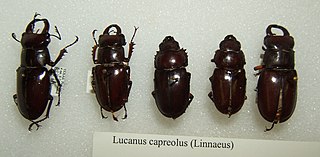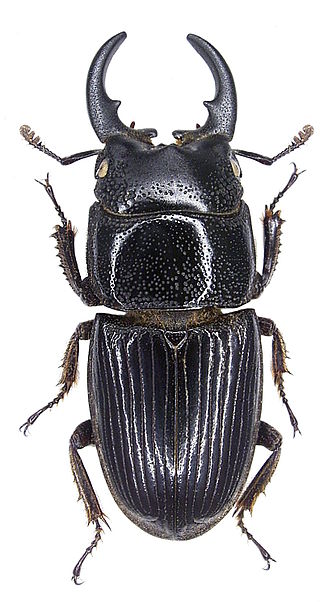
Stag beetles are a family of about 1,200 species of beetles in the family Lucanidae, currently classified in four subfamilies. Some species grow to over 12 centimetres, but most to about 5 cm (2 in).

Yangmingshan National Park is one of the nine national parks in Taiwan, located in both Taipei and New Taipei City. The districts that are partially in the park include Taipei's Beitou and Shilin Districts; and New Taipei's Wanli, Jinshan, Sanzhi and Tamsui Districts. The national park is known for its cherry blossoms, hot springs, sulfur deposits, fumaroles, venomous snakes, and hiking trails, including Taiwan's tallest dormant volcano, Qixing Mountain rising to 1,120 m (3,675 ft).

Lucanus cervus, known as the European stag beetle, or the greater stag beetle, is one of the best-known species of stag beetle in Western Europe, and is the eponymous example of the genus. L. cervus is listed as Near Threatened by the IUCN Red List.

Lucanus is a genus of stag beetles (Lucanidae).

Lucanus capreolus, the reddish-brown stag beetle or pinching beetle, is a beetle of the family Lucanidae. The specific name capreolus is derived from Latin, meaning "roe deer". The name refers to the resemblance of the mandibles to deer antlers.

Lucanus elaphus, the giant stag beetle or elephant stag beetle, is a beetle of the family Lucanidae native to eastern North America. They are sometimes kept as pets.

Lucanus formosanus is a stag beetle which is endemic to Taiwan, and grows to a length of 45–80 millimetres (1.8–3.1 in). Like other species in the Lucanid family, L. formosanus exhibits distinct sexual dimorphism and subsequent external morphological allometry in males. Males of the species develop mandibles of various forms depending on geographic location; i.e. northern, central, and southern morphs.

Lucanus maculifemoratus is a beetle of the family Lucanidae. This species is known as Miyama stag beetle in Japan. These beetles have a light covering of golden hair on their back, mostly around the rear edges.

Lucanus tetraodon is a stag beetle of the family Lucanidae.

The Tatun Volcanic Group constitutes a group of volcanoes located in northern Taiwan. It is located 15 km north of Taipei, and lies to the west of Keelung. It just adjoins the northern coast of the Taiwan island. The volcanic group was a result of episodic volcanism between 2.8 and 0.2 Ma. As of 2005, some geothermal activity was occurring and gas fumaroles were active among these volcanoes. Observations of the Tatun Volcanic Group suggest that magma chambers probably still exist under the land surface of northern Taiwan.
The Lucanidae are a family of beetles that include the stag beetles. The family can be further subdivided in a taxonomy. The classification presented here follows Smith (2006), with the exception of the tribal classification within the Lucaninae.

Cyclommatus is a genus of the family Lucanidae, also known as the stag beetle. The majority of the species from the genus Cyclommatus are located in Southeast Asia, though some species are found in China and Taiwan as well. The genus Cyclommatus also consists of three subgenera: Cyclommatus, Cyclommatinus and Cyclommatellus. Each subgenera contains 80, 24 and 3 species respectively. In total, the genus Cyclommatus consists of a total of 134 species, though more are still being discovered to this day.

Lamprima aenea is a species of beetle in the family Lucanidae that is found on Norfolk Island. It has size of 27–30 mm for males and 23 to 26 mm for females.It has color variations such as dark bronze and blue and green as its typical color; there also are some breeders of Lamprina aenea in Japan and Taiwan. Due to the destruction of its natural habitat it became rare in the wild, the Norfolk Island become ionly endemic stag beetle.

Lucanus laminifer is a species of beetles of the family Lucanidae.

Paralissotes reticulatus, also called the New Zealand reticulate stag beetle, is a native species of stag beetle from New Zealand. Although they do have wings they are flightless.

Geodorcus helmsi,New Zealand giant stag beetle or Helms's stag beetle is a large, slow-moving, flightless stag beetle in the family Lucanidae. It is endemic to New Zealand.

Geodorcus alsobius, or Moehau stag beetle, is a large flightless species of stag beetle in the family Lucanidae. It is found only on Mt Moehau, the highest mountain in the Moehau Range on the Coromandel Peninsula in New Zealand.

Geodorcus ithaginis, the Mokohinau stag beetle, is a large flightless species of stag beetle in the family Lucanidae. It was described by Thomas Broun in 1893 after being discovered in the Mokohinau Islands by Andreas Stewart Sandager, a lighthouse keeper on the islands. The species survives only on the small unnamed island "Stack H", in a patch of vegetation the size of a living room, and is in extreme danger of extinction.

Geodorcus servandus is a large flightless species of stag beetle in the family Lucanidae. It was discovered by P.R. Kettle in December 1960 and this holotype specimen is held in the New Zealand Arthropod Collection. It was first described by Beverley Holloway in 2007. Its type location is Mount Tuhua summit, near Lake Kaniere on the West Coast of New Zealand. The name servandus is a Latin word meaning "[something] to be preserved, conserved, looked after".

Aegus chelifer, is a species of stag beetle found in Indo-Malaya regional countries.

















